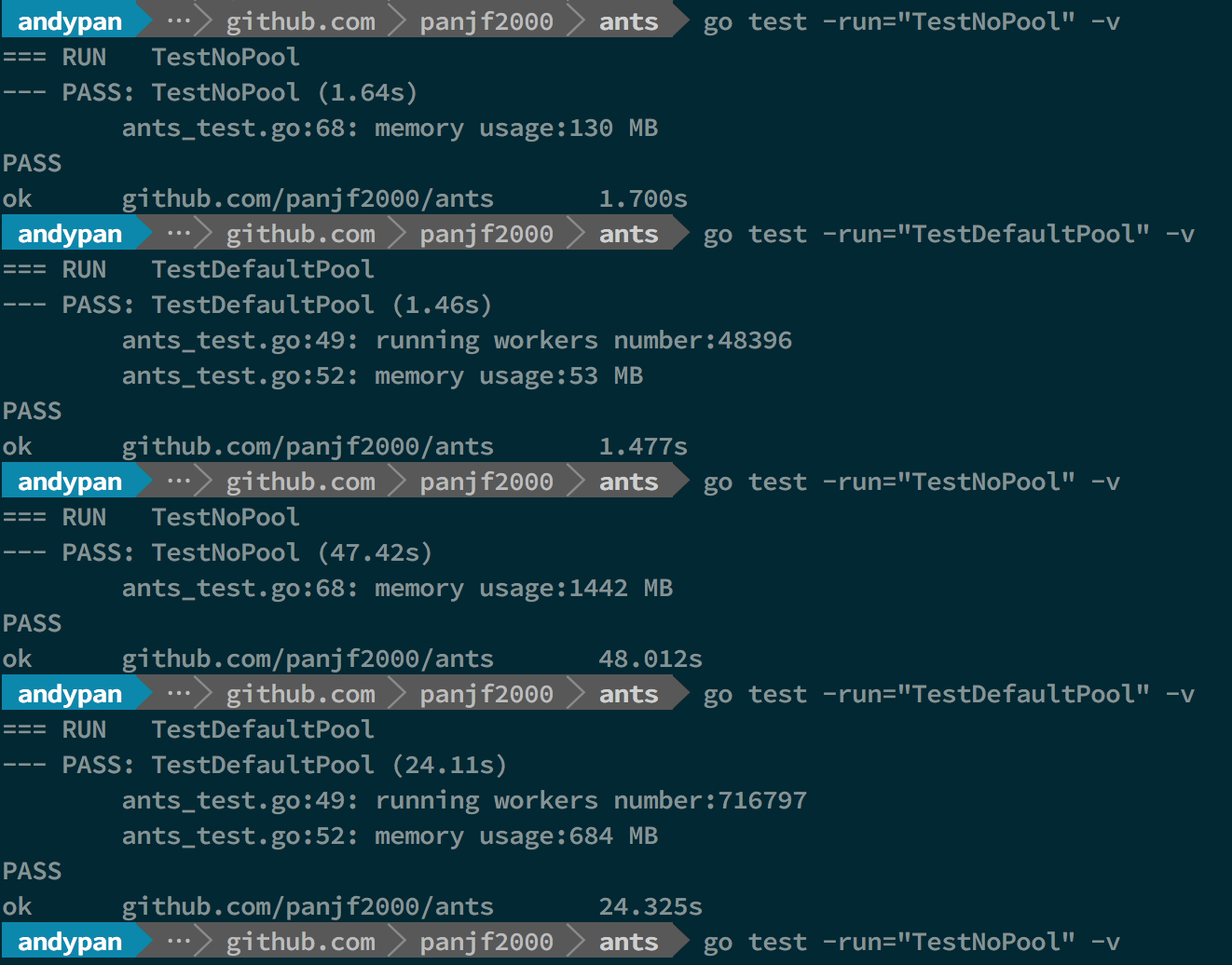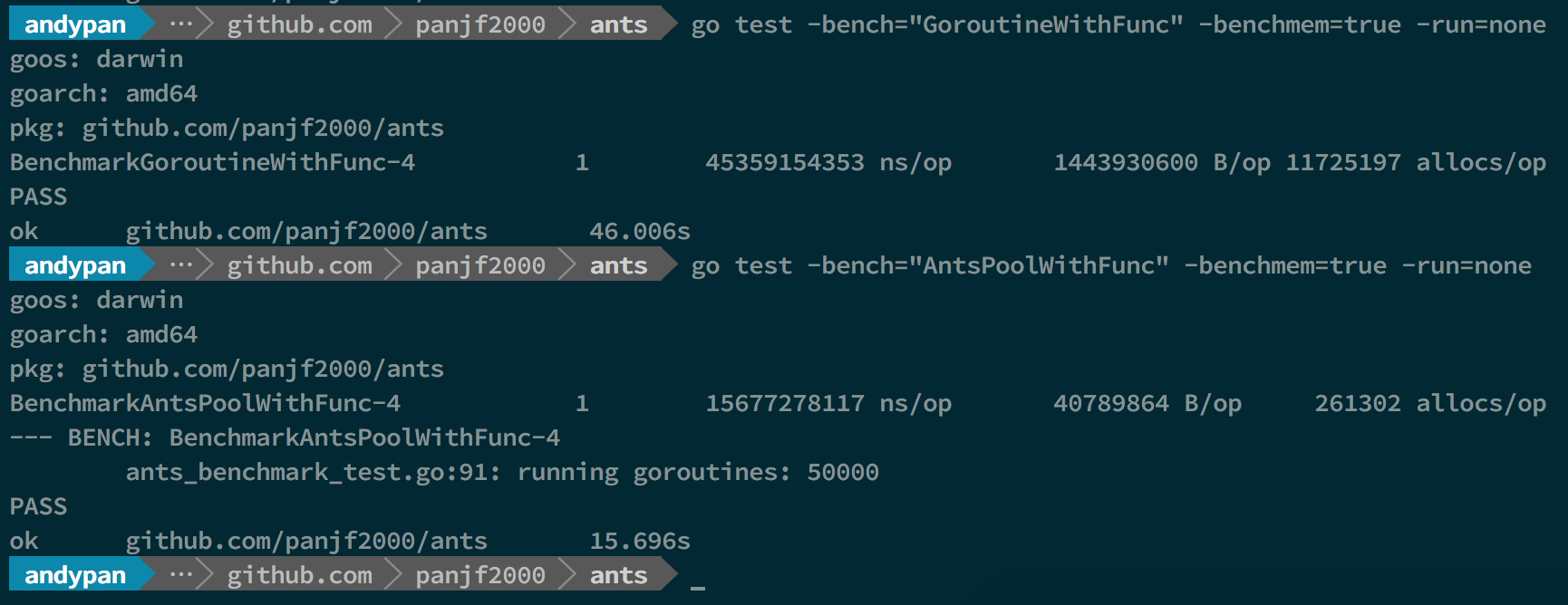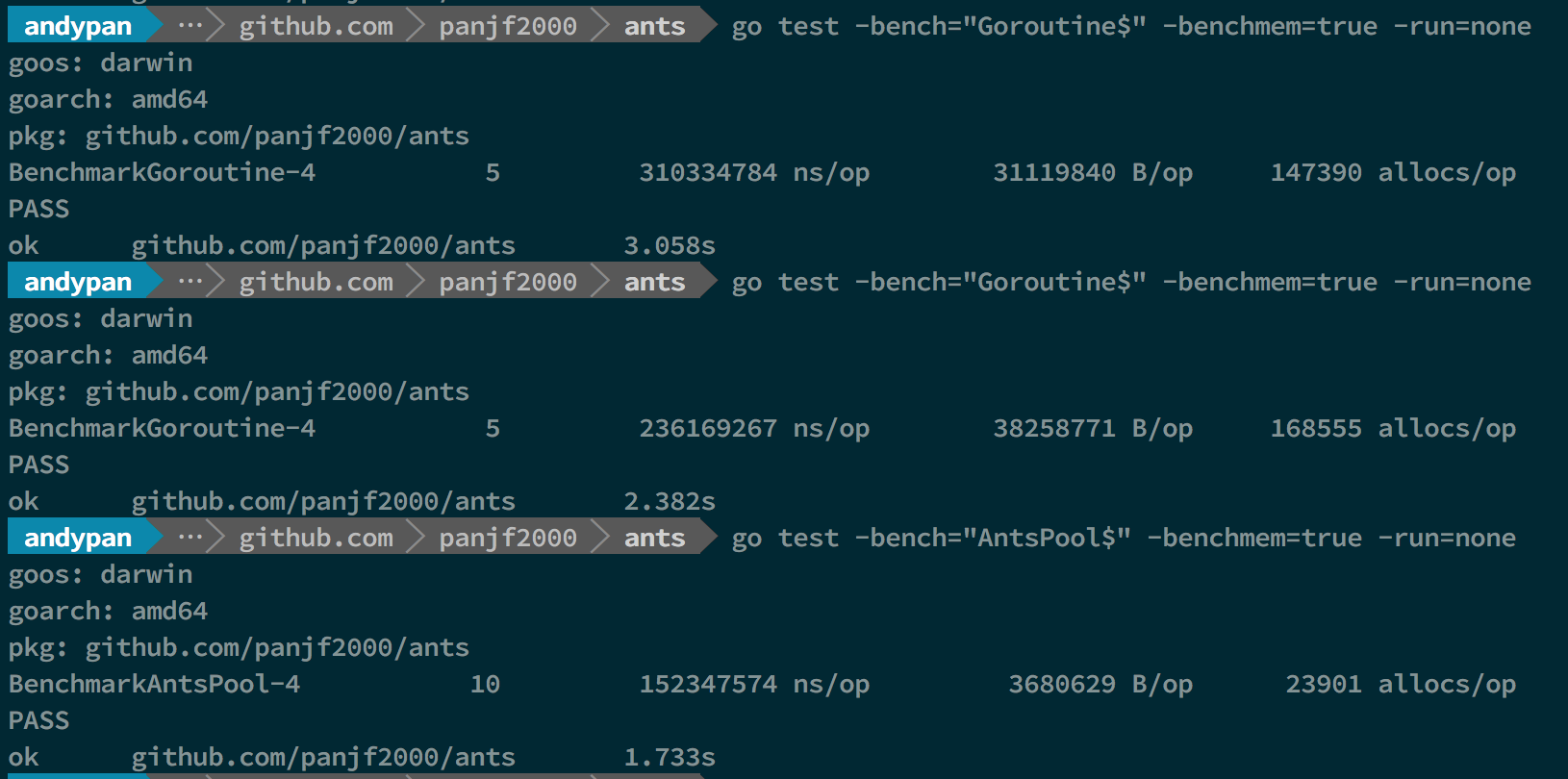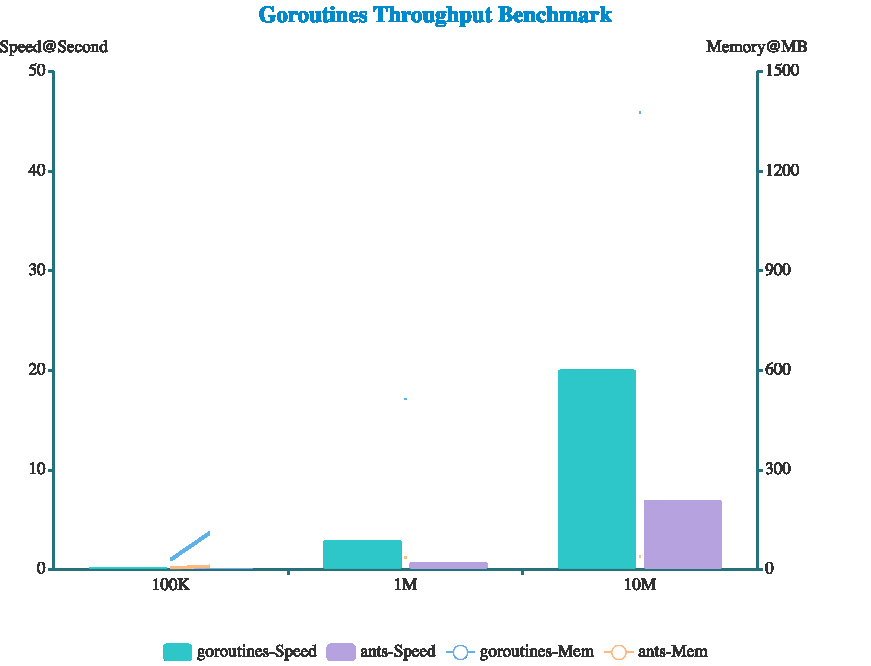Library ants implements a goroutine pool with fixed capacity, managing and recycling a massive number of goroutines, allowing developers to limit the number of goroutines in your concurrent programs.
- Automatically managing and recycling a massive number of goroutines.
- Periodically purging overdue goroutines.
- Friendly interfaces: submitting tasks, getting the number of running goroutines, tuning capacity of pool dynamically, closing pool.
- Handle panic gracefully to prevent programs from crash.
- Efficient in memory usage and it even achieves higher performance than unlimited goroutines in golang.
- 1.8.x
- 1.9.x
- 1.10.x
- 1.11.x
- 1.12.x
go get -u github.com/panjf2000/antsOr, using glide:
glide get github.com/panjf2000/antsJust take a imagination that your program starts a massive number of goroutines, from which a vast amount of memory will be consumed. To mitigate that kind of situation, all you need to do is to import ants package and submit all your tasks to a default pool with fixed capacity, activated when package ants is imported:
package main
import (
"fmt"
"sync"
"sync/atomic"
"time"
"github.com/panjf2000/ants"
)
var sum int32
func myFunc(i interface{}) {
n := i.(int32)
atomic.AddInt32(&sum, n)
fmt.Printf("run with %d\n", n)
}
func demoFunc() {
time.Sleep(10 * time.Millisecond)
fmt.Println("Hello World!")
}
func main() {
defer ants.Release()
runTimes := 1000
// Use the common pool.
var wg sync.WaitGroup
syncCalculateSum := func() {
demoFunc()
wg.Done()
}
for i := 0; i < runTimes; i++ {
wg.Add(1)
ants.Submit(syncCalculateSum)
}
wg.Wait()
fmt.Printf("running goroutines: %d\n", ants.Running())
fmt.Printf("finish all tasks.\n")
// Use the pool with a function,
// set 10 to the capacity of goroutine pool and 1 second for expired duration.
p, _ := ants.NewPoolWithFunc(10, func(i interface{}) {
myFunc(i)
wg.Done()
})
defer p.Release()
// Submit tasks one by one.
for i := 0; i < runTimes; i++ {
wg.Add(1)
p.Invoke(int32(i))
}
wg.Wait()
fmt.Printf("running goroutines: %d\n", p.Running())
fmt.Printf("finish all tasks, result is %d\n", sum)
}package main
import (
"io/ioutil"
"net/http"
"github.com/panjf2000/ants"
)
type Request struct {
Param []byte
Result chan []byte
}
func main() {
pool, _ := ants.NewPoolWithFunc(100, func(payload interface{}) {
request, ok := payload.(*Request)
if !ok {
return
}
reverseParam := func(s []byte) []byte {
for i, j := 0, len(s)-1; i < j; i, j = i+1, j-1 {
s[i], s[j] = s[j], s[i]
}
return s
}(request.Param)
request.Result <- reverseParam
})
defer pool.Release()
http.HandleFunc("/reverse", func(w http.ResponseWriter, r *http.Request) {
param, err := ioutil.ReadAll(r.Body)
if err != nil {
http.Error(w, "request error", http.StatusInternalServerError)
}
defer r.Body.Close()
request := &Request{Param: param, Result: make(chan []byte)}
// Throttle the requests traffic with ants pool. This process is asynchronous and
// you can receive a result from the channel defined outside.
if err := pool.Invoke(request); err != nil {
http.Error(w, "throttle limit error", http.StatusInternalServerError)
}
w.Write(<-request.Result)
})
http.ListenAndServe(":8080", nil)
}Tasks can be submitted by calling ants.Submit(func())
ants.Submit(func(){})ants also supports customizing the capacity of pool. You can invoke the NewPool function to instantiate a pool with a given capacity, as following:
// Set 10000 the size of goroutine pool
p, _ := ants.NewPool(10000)
// Submit a task
p.Submit(func(){})You can tune the capacity of ants pool in runtime with Tune(int):
pool.Tune(1000) // Tune its capacity to 1000
pool.Tune(100000) // Tune its capacity to 100000Don't worry about the synchronous problems in this case, the function here is thread-safe (or should be called goroutine-safe).
ants allows you to pre-allocate memory of goroutine queue in pool, which may get a performance enhancement under some special certain circumstances such as the scenario that requires an pool with ultra-large capacity, meanwhile each task in goroutine lasts for a long time, in this case, pre-mallocing will reduce a lot of costs when re-slicing goroutine queue.
// ants will pre-malloc the whole capacity of pool when you invoke this function
p, _ := ants.NewPoolPreMalloc(AntsSize)pool.Release()All tasks submitted to ants pool will not be guaranteed to be addressed in order, because those tasks scatter among a series of concurrent workers, thus those tasks would be executed concurrently.
OS: macOS High Sierra
Processor: 2.7 GHz Intel Core i5
Memory: 8 GB 1867 MHz DDR3
Go Version: 1.9
-
BenchmarkGoroutine-4 represents the benchmarks with unlimited goroutines in golang.
-
BenchmarkPoolGroutine-4 represents the benchmarks with a
antspool.
The test data above is a basic benchmark and more detailed benchmarks are about to be uploaded later.
In above benchmark picture, the first and second benchmarks performed test cases with 1M tasks and the rest of benchmarks performed test cases with 10M tasks, both in unlimited goroutines and ants pool, and the capacity of this ants goroutine-pool was limited to 50K.
As you can see, ants can up to 2x faster than goroutines without pool (10M tasks) and it only consumes half the memory comparing with goroutines without pool. (both 1M and 10M tasks)
Throughput (it is suitable for scenarios where asynchronous tasks are submitted despite of the final results)
In conclusion, ants can up to 2x~6x faster than goroutines without a pool and the memory consumption is reduced by 10 to 20 times.











